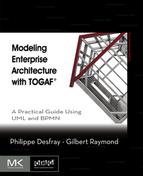Table of Contents
Chapter 1: TOGAF®: General Presentation
2.4 ADM techniques and guidelines
Chapter 3: The Components of TOGAF Architecture
Chapter 4: The Repository and Governance
4.1 The architecture repository
Chapter 5: Key Modeling Techniques
5.1 Models: Benefits, uses, and characteristics
5.3 Special role played by diagrams
5.4 Consistency and traceability
5.6 Risks and main difficulties
Chapter 6: Introduction to TOGAF Models
6.2 UML and BPMN for TOGAF modeling
6.3 The “Discount Travel” enterprise
Chapter 7: Models for Phase A: Vision
7.4 Artifacts linked to requirements
7.5 Artifacts linked to business processes
7.6 The “Solution concept diagram” artifact
7.7 The “Value chain diagram” artifact
Chapter 8: Models for Phase B: Business Architecture
8.2 The “business dictionary” artifact
8.3 Artifacts linked to enterprise organization
8.4 Artifacts linked to enterprise functions and services
8.5 Artifacts linked to business processes
Chapter 9: Models for Phase C: Information System Architecture
9.2 The “application communication diagram” artifact
9.3 The “application migration diagram” artifact
9.4 The “application and user location diagram” artifact
9.5 The “system use case diagram” artifact
9.6 The “process system realization diagram” artifact
9.7 The “enterprise manageability diagram” artifact
9.9 The “service data diagram” artifact (Figure 9.14)
Chapter 10: Models for Phase D: Technology Architecture
10.2 The “Environment and location diagram” artifact
10.3 The “Processing diagram” artifact
10.4 The “Network computing hardware diagram” artifact
Chapter 11: Models for Phase E: Opportunities and Solutions
11.2 The “Benefits diagram” artifact
Chapter 12: SOA, Processes, and Information
12.1 Service-Oriented Architecture
13.3 TOGAF within the EDF Group
14.2 ArchiMate to EAP correspondence examples
15.1 Mapping UML and BPMN to TOGAF
15.3 Global structure and architecture domains
15.5 Business architecture (Figure 15.6)
15.6 Application architecture (Figure 15.8)
